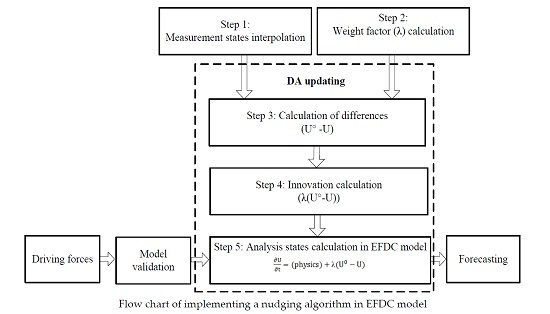Hindcasting and Forecasting of Surface Flow Fields through Assimilating High Frequency Remotely Sensing Radar Data
Abstract
:1. Introduction
2. Methodologies
2.1. High Frequency Radar System
2.2. Numerical Model
2.3. Data Assimilation
2.4. Implementation of Data Assimilation
3. Sensitivity Experiments
3.1. Tests of Nudging Parameters
3.2. Tests of Data Assimilation Cycle Lengths
4. Forecast Assessments of Assimilation Cycle Lengths
4.1. Assessment of Mean Surface Flow Fields
4.2. Data Assimilation Skill Score Assessment
4.3. Averaaged Kinetic Energy Assessment
4.4. Assessment of Surface Velocity Components
4.5. Assessment of Forecasted Surface Flow Fields
5. Discussion
6. Conclusions
- (1)
- Sensitivity tests performed on the nudging data assimilation parameters suggest that an influence depth of 4 m and an assimilation timescale of 1800 s were the suitable values for developing the data assimilation system for Galway Bay based on RMSE analysis during a hindcasting period. Further analysis indicated that surface flow fields were more sensitive to the depth of influence than the assimilation time scale. This is the first study that has investigated the effects of the system parameters on results, and to provide guidance for future application of this algorithm.
- (2)
- The research showed that modelling performance was also quite sensitive to data assimilation cycle lengths. Assimilation of radar data at each model computational timestep significantly improved model forecasting in comparison with using longer data assimilation cycle lengths. The RMSE of the averaged velocity components over a half-day forecasting period between the radar data and the best nudging data assimilation model was smaller than model forecasts using longer cycle lengths. The averaged east–west and north–south velocity components from the best model (NDA21) were improved by 10% and 15%, compared with the “free run”, respectively. However, there were no distinct improvements in RMSE between the other models with longer data assimilation cycle lengths. The results presented herein demonstrated better performance than all other published results in investigating this area. Additionally, results indicated that the same nudging assimilation parameters can be used for models with different cycle lengths.
- (3)
- The calculation of surface flow fields were enhanced during the forecasting period when data assimilation was employed at each model computational timestep. Surface flow fields from other assimilation models with longer cycle lengths did not significantly improve compared with model NDA0. This was the first time such a sensitivity analysis was performed.
- (4)
- The values of DASS generated during this research proved that model NDA21 improved model performance by 26% and 33% for east–west and north–south velocity components, respectively, during a +6 h forecasting period for Galway Bay; these were significant improvements.
- (5)
- Analysis of AKE further proved that updating model background states at each model computational timestep resulted in forecasting improvements. Correlation of AKE between the best nudging data assimilation model NDA21 and the radar data was improved by 12% compared with model NDA0 over a two-day forecasting. The improvement, herein, was comparable with other studies.
- (6)
- Time series graphs at a location within Galway Bay showed that implementation of data assimilation at each model step using interpolated radar data greatly enhanced both surface velocity components during forecasting period, especially for the north–south surface velocity component. Results from other assimilation models with longer data assimilation cycle lengths did not generate distinct improvements on the model forecasts; they followed the same trend as the “free run”.
- (7)
- Surface flow fields at a representative measurement timestep, 03:00 Julian Day 228, show that the best assimilation model produced significantly better surface flow circulation through the domain than the “free run” did. Improvements of vector directions in the domain were in the order of 20% at this time, compared with the “free run”.
Acknowledgments
Author Contributions
Conflicts of Interest
References
- Robert, C.L.; Blayo, E.; Verron, J. Comparison of reduced-order, sequential and variational data assimilation methods in the tropical Pacific Ocean. Ocean Dyn. 2006, 56, 624–633. [Google Scholar] [CrossRef]
- Ide, K.; Courtier, P.; Ghil, M.; Lorenc, A.C. Unified notation for data assimilation operational, sequential and variational. J. Meteorol. Soc. Jpn. 1997, 75, 181–189. [Google Scholar] [CrossRef]
- Madsen, H.; Hartnack, J.; Sørensen, J.V.T. Data assimilation in a flood modelling system using the Ensemble Kalman filter. In Proceedings of the XVI International Conference on Computational Methods in Water Resources, Copenhagen, Denmark, 19–22 June 2006. [Google Scholar]
- Evensen, G. The Ensemble Kalman Filter: Theoretical formulation and practical implementation. Ocean Dyn. 2003, 53, 343–367. [Google Scholar] [CrossRef]
- Gopalakrishnan, G.; Blumberg, A.F. Assimilation of HF radar-derived surface currents on tidal-timescales. J. Oper. Oceanogr. 2012, 5, 75–87. [Google Scholar] [CrossRef]
- Isern-Fontanet, J.; Ballabrera-Poy, J.; Turiel, A.; Garcia-Ladona, E. Retrieval and assimilation of velocities at the ocean surface. Nonlinear Process. Geophys. 2017, 1–37. [Google Scholar] [CrossRef]
- Moore, A.M.; Arango, H.G.; Broquet, G.; Powell, B.S.; Weaver, A.T.; Zavala-Garay, J. The Regional Ocean Modeling System (ROMS) 4-dimensional variational data assimilation systems: Part I—System overview and formulation. Prog. Oceanogr. 2011, 91, 34–49. [Google Scholar] [CrossRef]
- Hoteit, I.; Cornuelle, B.; Kim, S.Y.; Forget, G.; Köhl, A.; Terrill, E. Assessing 4D-VAR for dynamical mapping of coastal high-frequency radar in San Diego. Dyn. Atmos. Oceans 2009, 48, 175–197. [Google Scholar] [CrossRef]
- Clayton, A.M.; Lorenc, A.C.; Barker, D.M. Operational implementation of a hybrid ensemble/4D-Var global data assimilation system at the Met Office. Q. J. R. Meteorol. Soc. 2013, 139, 1445–1461. [Google Scholar] [CrossRef]
- Ngodock, H.; Carrier, M. A 4DVAR system for the Navy Coastal Ocean Model. Part I: System description and assimilation of synthetic observations in Monterey Bay. Mon. Weather Rev. 2014, 142, 2085–2107. [Google Scholar] [CrossRef]
- Powell, B.S.; Arango, H.G.; Moore, A.M.; Di Lorenzo, E.; Milliff, R.F.; Foley, D. 4DVAR data assimilation in the Intra-Americas Sea with the Regional Ocean Modeling System (ROMS). Ocean Model. 2008, 25, 173–188. [Google Scholar] [CrossRef]
- Paduan, J.D.; Shulman, I. HF radar data assimilation in the Monterey Bay area. J. Geophys. Res. 2004, 109, 434–446. [Google Scholar] [CrossRef]
- Ren, L.; Nash, S.; Hartnett, M. Forecasting of surface currents via correcting wind stress with assimilation of high-frequency radar data in a three-dimensional model. Adv. Meteorol. 2016, 2016, 1–12. [Google Scholar] [CrossRef]
- Barth, A.; Alvera-Azcarate, A.; Weisberg, R.H. Assimilation of high-frequency radar currents in a nested model of the West Florida Shelf. J. Geophys. Res. 2008, 113, 1–15. [Google Scholar] [CrossRef]
- Breivik, O.; Satra, O. Real time assimilation of HF radar currents into a coastal ocean model. J. Mar. Syst. 2001, 28, 161–182. [Google Scholar] [CrossRef]
- Fan, S.; Oey, L.Y.; Hamilton, P. Assimilation of drifter and satellite data in a model of the Northeastern Gulf of Mexico. Cont. Shelf Res. 2004, 24, 1001–1013. [Google Scholar] [CrossRef]
- Castellari, S.; Griffa, A.; Ozgokmen, T.M.; Poulain, P.M. Prediction of particle trajectories in the Adriatic sea using Lagrangian data assimilation. J. Mar. Syst. 2001, 29, 33–50. [Google Scholar] [CrossRef]
- Lin, X.H.; Oey, L.Y.; Wang, D.P. Altimetry and drifter data assimilations of loop current and eddies. J. Geophys. Res. 2007, 112. [Google Scholar] [CrossRef]
- Dabrowski, T. A Flushing Study Analysis of Selected Irish Waterbodies. Ph.D. Thesis, National University of Ireland Galway, Galway, Ireland, 2005. [Google Scholar]
- O’Donncha, F.; Hartnett, M.; Nash, S.; Ren, L.; Ragnoli, E. Characterizing observed circulation patterns within a bay using HF radar and numerical model simulations. J. Mar. Syst. 2014, 142, 96–110. [Google Scholar] [CrossRef]
- Wang, J.; Dizaji, R.; Ponsford, A.M. Analysis of clutter distribution in bistatic high frequency surface wave radar. In Proceedings of the 2004 Canadian Conference on Electrical and Computer Engineering, Niagara Falls, ON, Canada, 2–5 May 2004; pp. 1301–1304. [Google Scholar]
- Haus, B.K.; Wang, J.D.; Rivera, J.; Martinez-Pedraja, J.; Smith, N. Remote radar measurement of shelf currents off key largo, Florida, U.S.A. Estuar. Coast. Shelf Sci. 2000, 51, 553–569. [Google Scholar] [CrossRef]
- Ojo, T.O.; Bonner, J.S.; Page, C.A. Simulation of constituent transport using a reduced 3D constituent transport model (CTM) driven by HF Radar: Model application and error analysis. Environ. Model. Softw. 2007, 22, 488–501. [Google Scholar] [CrossRef]
- Lipa, B.; Barrick, D.; Alonso-Martirena, A.; Fernandes, M.; Ferrer, M.; Nyden, B. Brahan project high frequency radar ocean measurements: Currents, winds, waves and their interactions. Remote Sens. 2014, 6, 12094–12117. [Google Scholar] [CrossRef]
- Lipa, B.; Whelan, C.; Rector, B.; Nyden, B. HF radar bistatic measurement of surface current velocities: drifter comparisons and radar consistency checks. Remote Sens. 2009, 1, 1190–1211. [Google Scholar] [CrossRef]
- Shulman, I.; Paduan, J.D. Assimilation of HF radar-derived radials and total currents in the Monterey Bay area. Deep Sea Res. Part II Top. Stud. Oceanogr. 2009, 56, 149–160. [Google Scholar] [CrossRef] [Green Version]
- Paduan, J.D.; Washburn, L. High-frequency radar observations of ocean surface currents. Ann. Rev. Mar. Sci. 2013, 5, 115–136. [Google Scholar] [CrossRef] [PubMed]
- Emery, B.M.; Washburn, L.; Harlan, J.A. Evaluating radial current measurements from CODAR high-frequency radars with moored current meters. J. Atmos. Ocean. Technol. 2003, 21, 1259–1271. [Google Scholar] [CrossRef]
- Liu, Y.; Weisberg, R.H.; Merz, C.R.; Lichtenwalner, S.; Kirkpatrick, G.J. HF Radar performance in a low-energy environment: CODAR SeaSonde experience on the West Florida Shelf. J. Atmos. Ocean. Technol. 2010, 27, 1689–1710. [Google Scholar] [CrossRef]
- Hamrick, J.M. EFDC Technical Memorandum; US Environmental Protection: Fairfax, VA, USA, 2006.
- TetraTech. The Environmental Fluid Dynamics Code Theory and Computation Volume 1: Hydrodynamics and Mass Transport; Tetra Tech, Inc.: Virginia Beach, VA, USA, 2007; p. 60. [Google Scholar]
- Hamrick, J.M. A Three-Dimensional Environmental Fluid Dynamics Computer Code: Therotical and Computatonal Aspects; Virginia Institute of Marine Science: Gloucester Point, VA, USA, 1992. [Google Scholar]
- Zou, R.; Carter, S.; Shoemaker, L.; Parker, A.; Henry, T. An integrated hydrodynamic and water quality modeling system to support nutrient TMDL development for Wissahickon Creek. J. Environ. Eng. 2006, 132, 555–566. [Google Scholar] [CrossRef]
- Jin, K.R.; Ji, Z.G. Case Study: Modeling of sediment transport and wind-wave impact in Lake Okeechobee. J. Hydraul. Eng. 2004, 130, 1055–1067. [Google Scholar] [CrossRef]
- O’Donncha, F.; Hartnett, M.; Nash, S. Physical and numerical investigation of the hydrodynamic implications of aquaculture farms. Aquac. Eng. 2013, 52, 14–26. [Google Scholar] [CrossRef]
- Wen, L. Three-Dimensional Hydrodynamic Modelling in Galway Bay; University College Galway: Galway, Ireland, 1995. [Google Scholar]
- Nagle, D. Modelling and Observation of Wind-Driven Circulation in Galway Bay; National University of Ireland Galway: Galway, Ireland, 2013. [Google Scholar]
- Ren, L.; Nash, S.; Hartnett, M. Observation and modeling of tide- and wind-induced surface currents at Galway Bay. Water Sci. Eng. 2015, 8, 345–352. [Google Scholar] [CrossRef]
- Egbert, G.D.; Erofeeva, S.Y. Efficient inverse modeling of barotropic ocean tides. J. Atmos. Ocean. Technol. 2002, 19, 183. [Google Scholar] [CrossRef]
- Padman, L. A barotropic inverse tidal model for the Arctic Ocean. Geophys. Res. Lett. 2004, 31, 1–4. [Google Scholar] [CrossRef]
- Gopalakrishnan, G. Surface Current Observations Using High Frequency Radar and Its Assimilation into the New York Harbor Observing and Prediction System. Ph.D. Thesis, Stevens Institute of Technology, Hoboken, NJ, USA, 2008. [Google Scholar]
- Houser, P.R.; Shuttleworth, W.J.; Famiglietti, J.S.; Gupta, H.V.; Syed, K.H.; Goodrich, D.C. Integration of soil moisture remote sensing and hydrologic modeling using data assimilation. Water Resour. Res. 1998, 34, 3405–3420. [Google Scholar] [CrossRef]
- Rusu, L.; Guedes Soares, C. Impact of assimilating altimeter data on wave predictions in the western Iberian coast. Ocean Model. 2015, 96, 126–135. [Google Scholar] [CrossRef]
- Stauffer, D.R.; Seaman, N.L. Use of four-dimensional data assimilation in a limited-area mesoscale model. Part I: Experiments with synoptic-scale data. Mon. Weather Rev. 1990, 118, 1250–1277. [Google Scholar] [CrossRef]
- Sun, J. Convective-scale assimilation of radar data: Progress and challenges. Q. J. R. Meteorol. Soc. 2005, 131, 3439–3463. [Google Scholar] [CrossRef]
- Agostinho, P.; Gil, A.; Galeano, J.C. N.U.I Galway CODAR SeaSonde HF Radar System; Qualitas Remos: Galway, Ireland, 2012. [Google Scholar]
- Ren, L.; Nash, S.; Hartnett, M. Renewable energies offshore. In Chapter 24 Data Assimilation with High-Frequency (HF) Radar Surface Currents at a Marine Renewable Energy Test Site; Soares, C.G., Ed.; CRC Press: London, UK, 2015. [Google Scholar]
- Toba, Y. Local balance in the air-sea boundary processes. J. Oceanogr. Soc. Jpn. 1973, 29, 209–220. [Google Scholar] [CrossRef]
- Ren, L.; Hartnett, M.; Nash, S. Assessment methods of data assimilation in oceanographic model forecasting. In Proceedings of the 36th IAHR World Congress, Delft, The Netherlands, 28 June–3 July 2015; pp. 1–10. [Google Scholar]
- Levy, G.; Coon, M.; Nguyen, G.; Sulsky, D. Physically-based data assimilation. Geosci. Model Dev. 2010, 3, 669–677. [Google Scholar] [CrossRef] [Green Version]
- Xu, J.; Huang, J.; Gao, S.; Cao, Y. Assimilation of high frequency radar data into a shelf sea circulation model. J. Ocean Univ. China 2014, 13, 572–578. [Google Scholar] [CrossRef]
- Thiebaux, H.J. Anisotropic correction functions for objective analysis. Mon. Weather Rev. 1976, 104, 994–1002. [Google Scholar] [CrossRef]
- Zhao, J.; Chen, X.; Xu, J.; Hu, W.; Chen, J.; Pohlmann, T. Assimilation of surface currents into a regional model over Qingdao coastal waters of China. Acta Oceanol. Sin. 2013, 32, 21–28. [Google Scholar] [CrossRef]
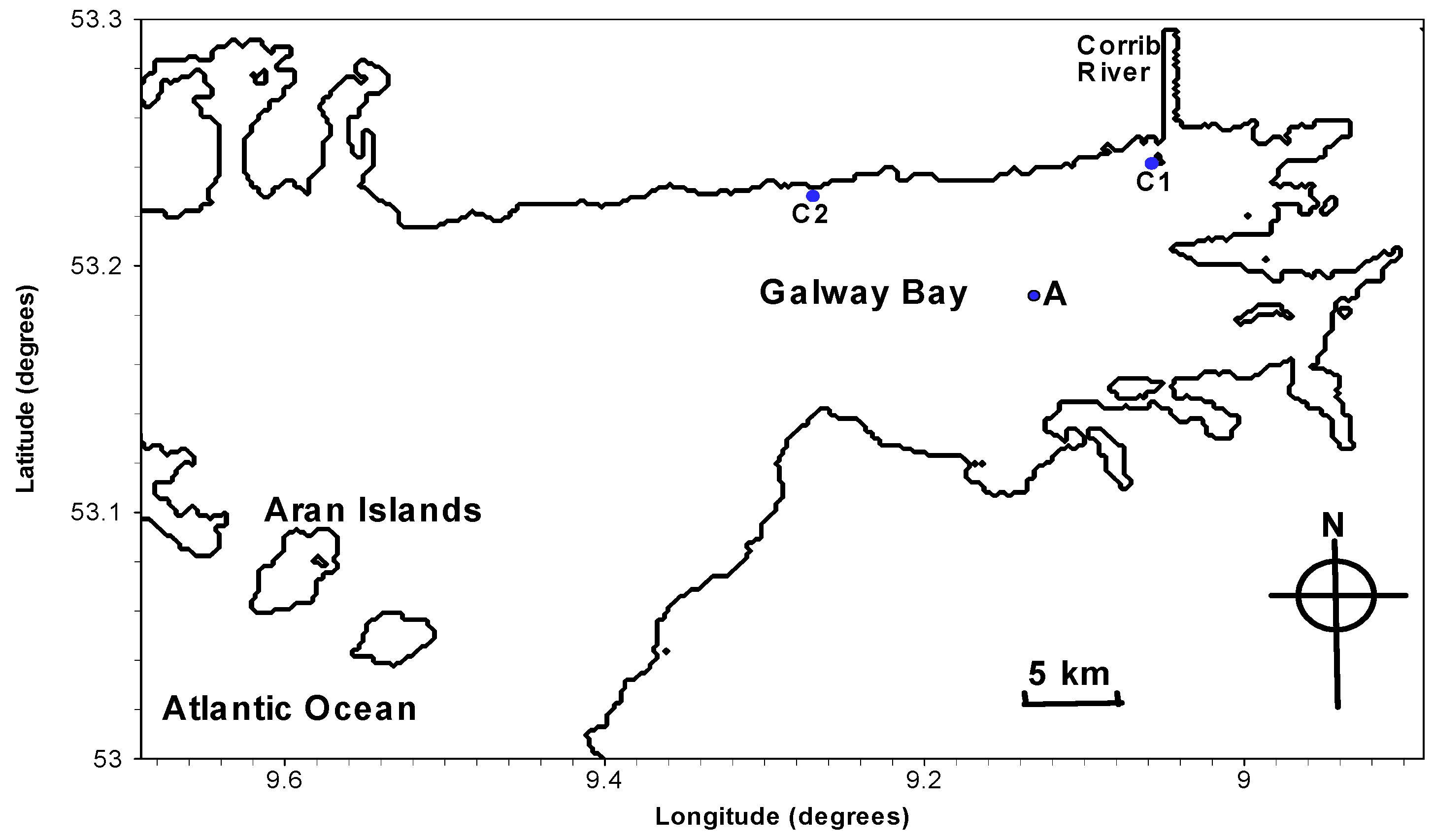

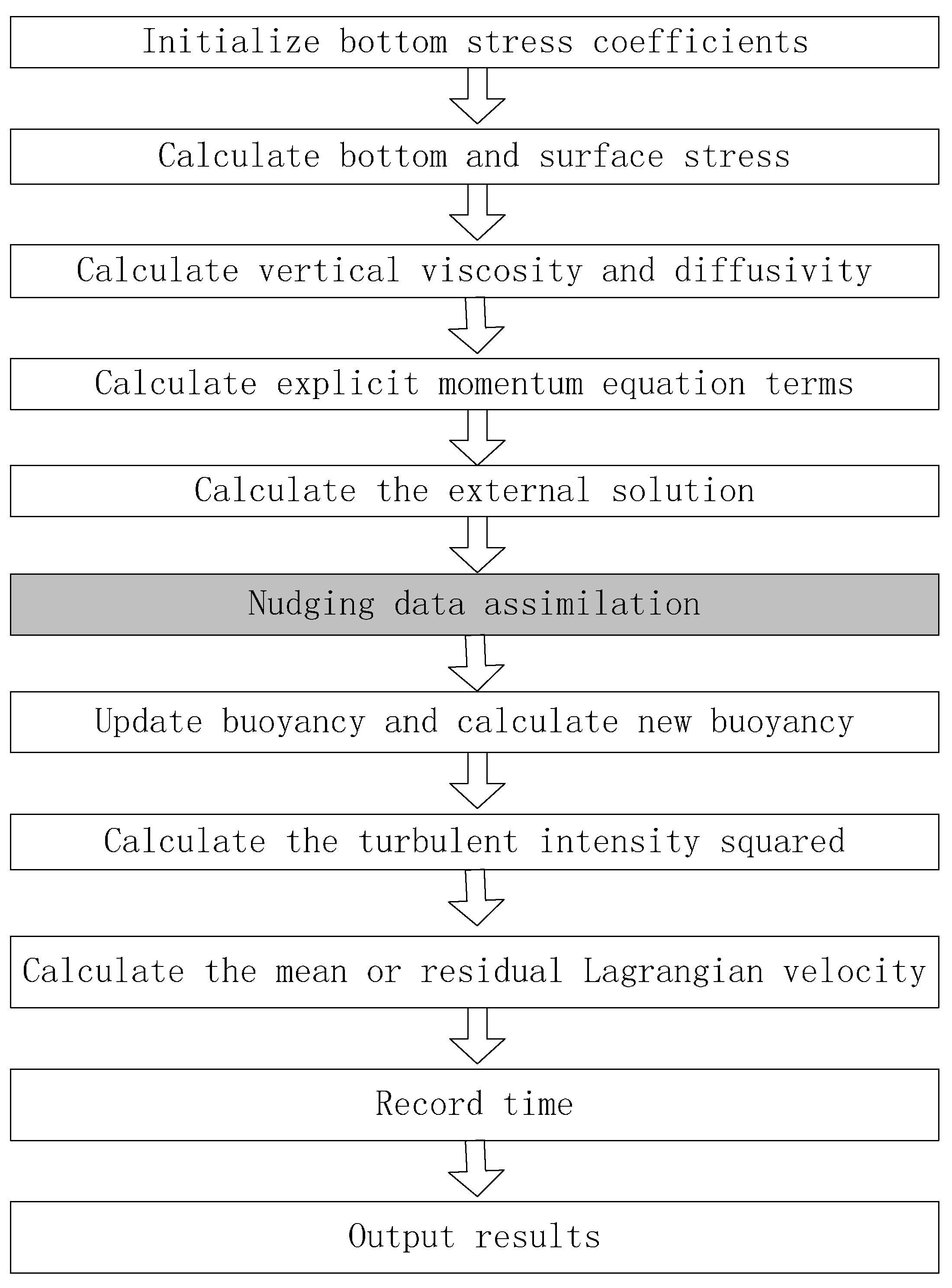
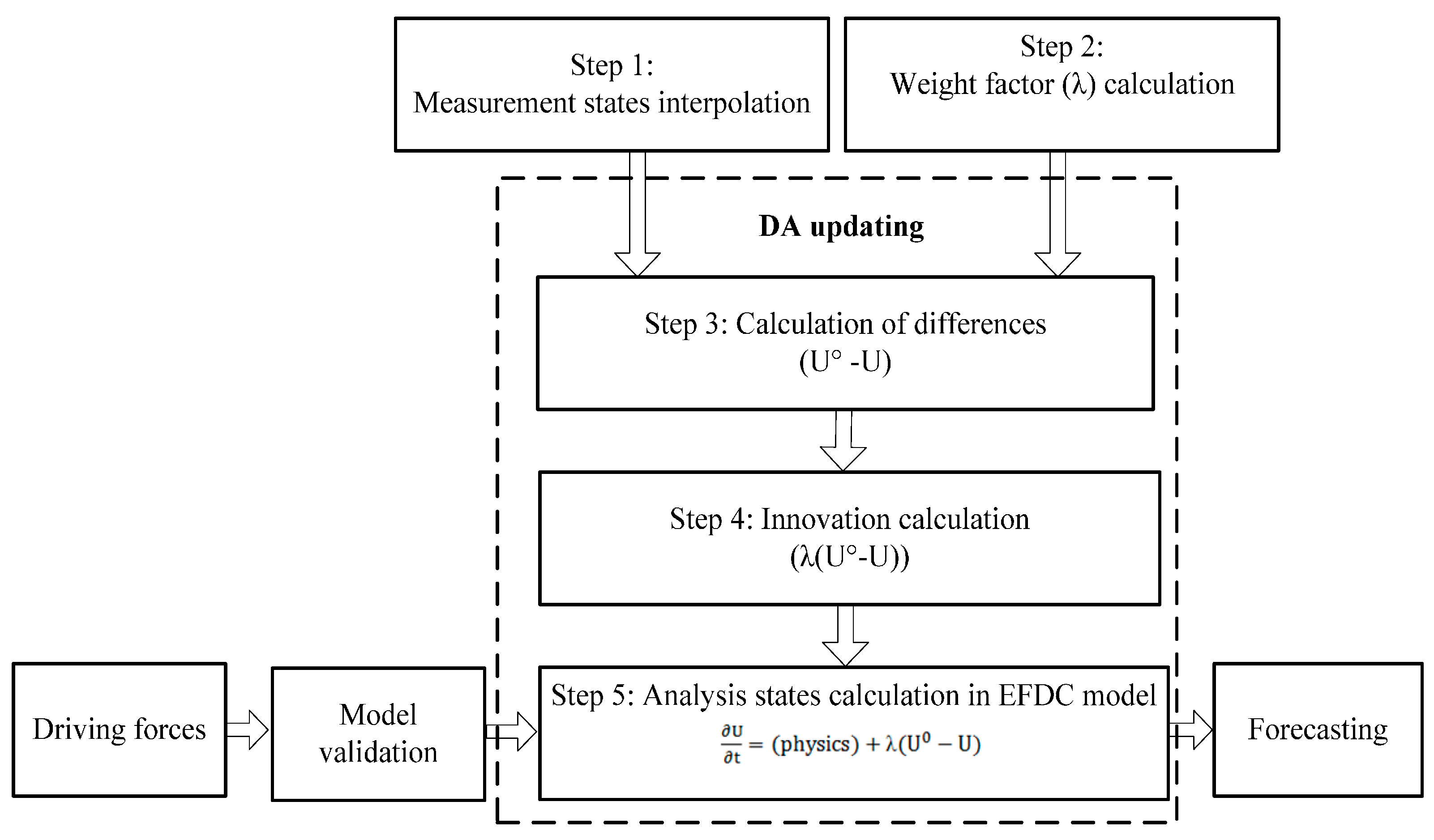
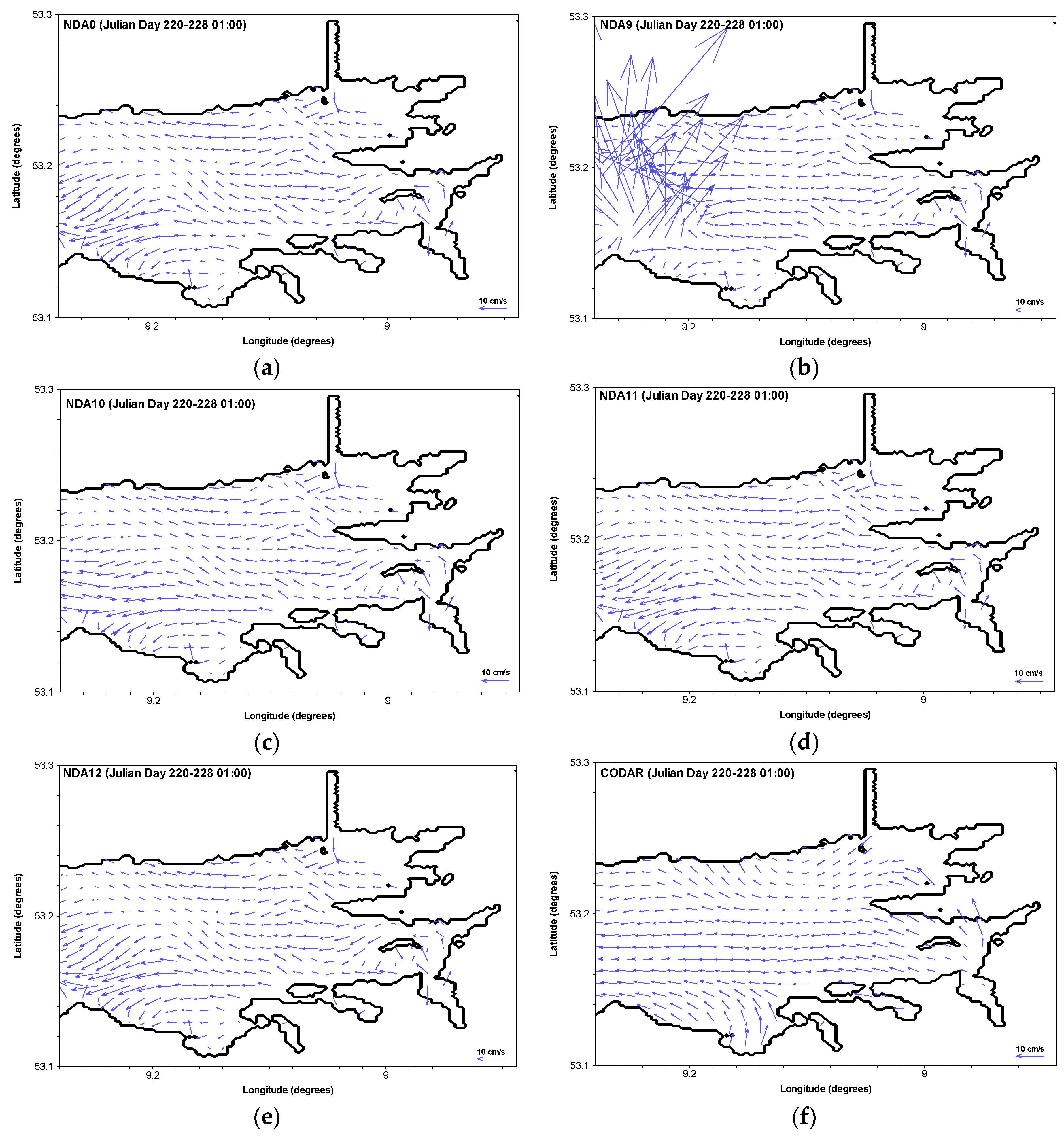
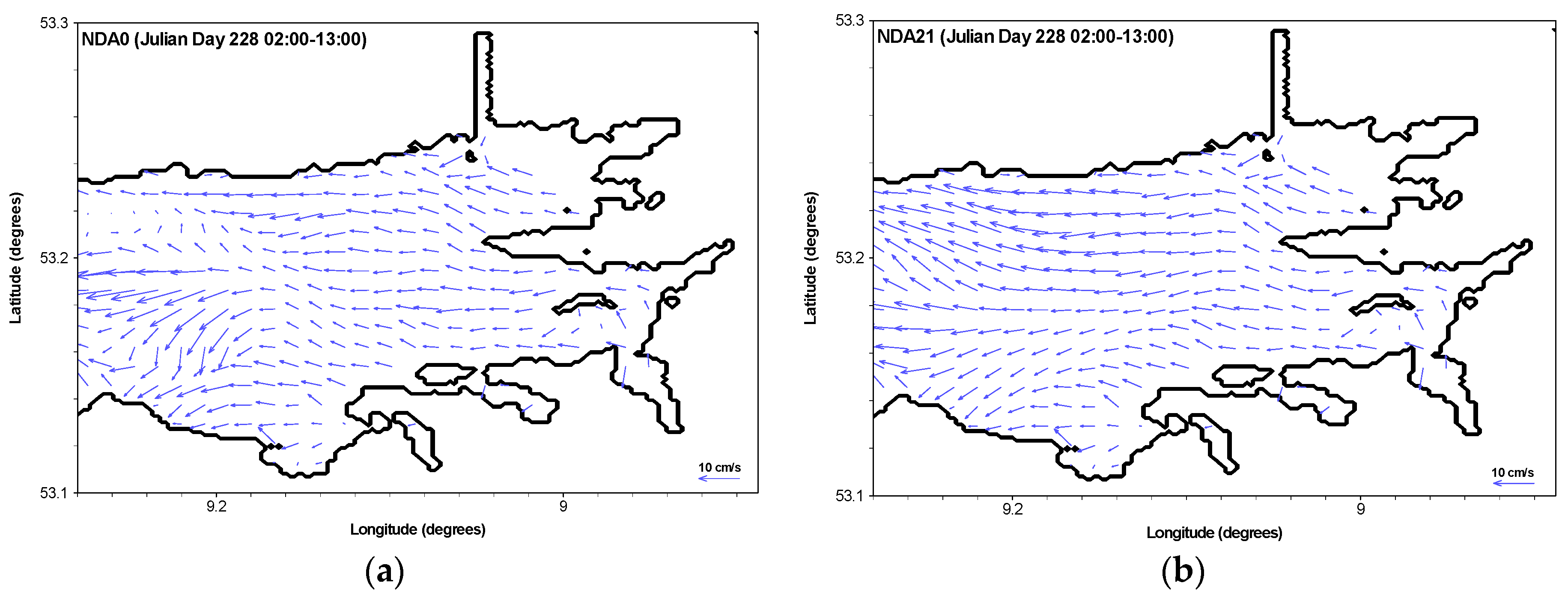
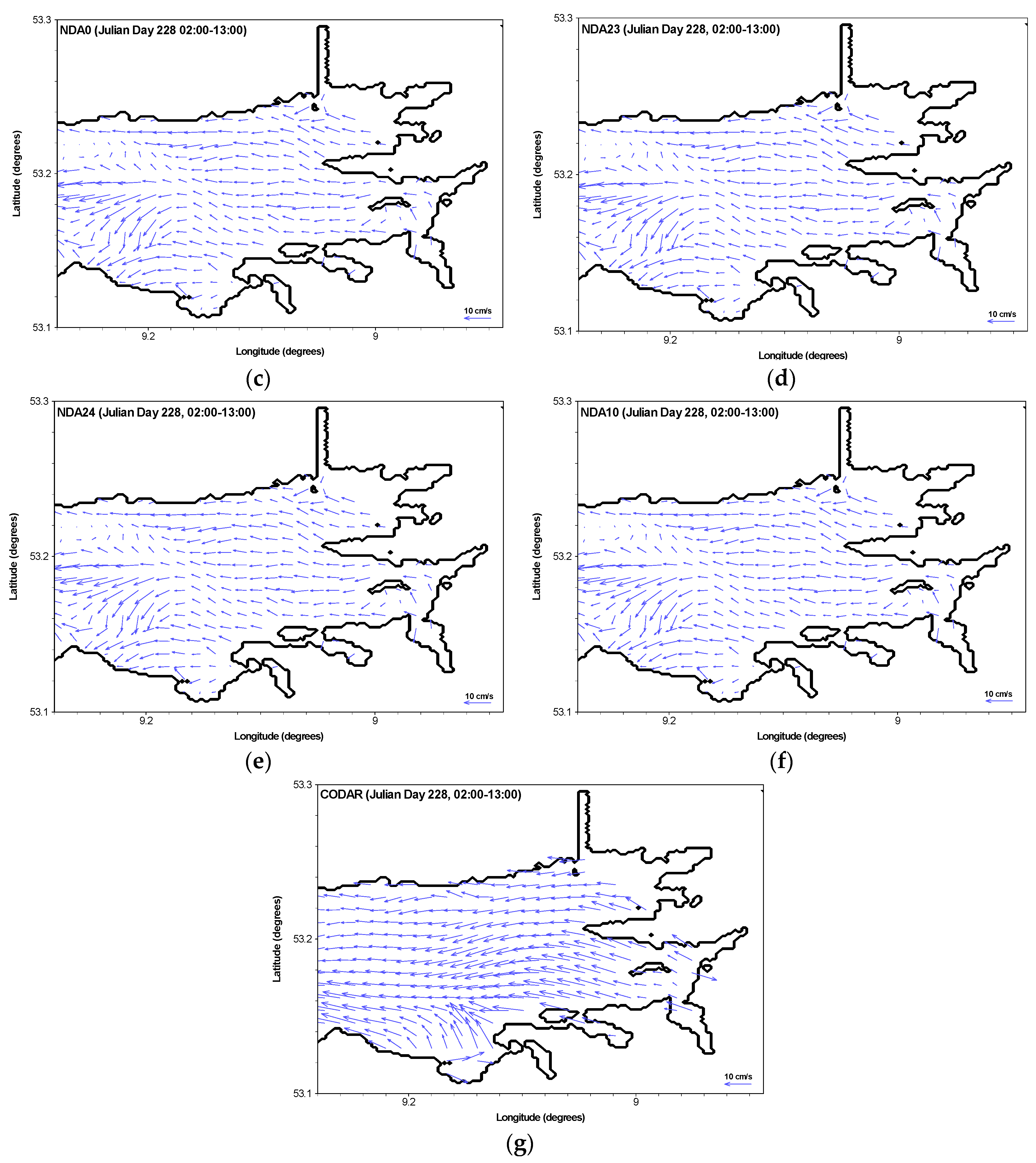
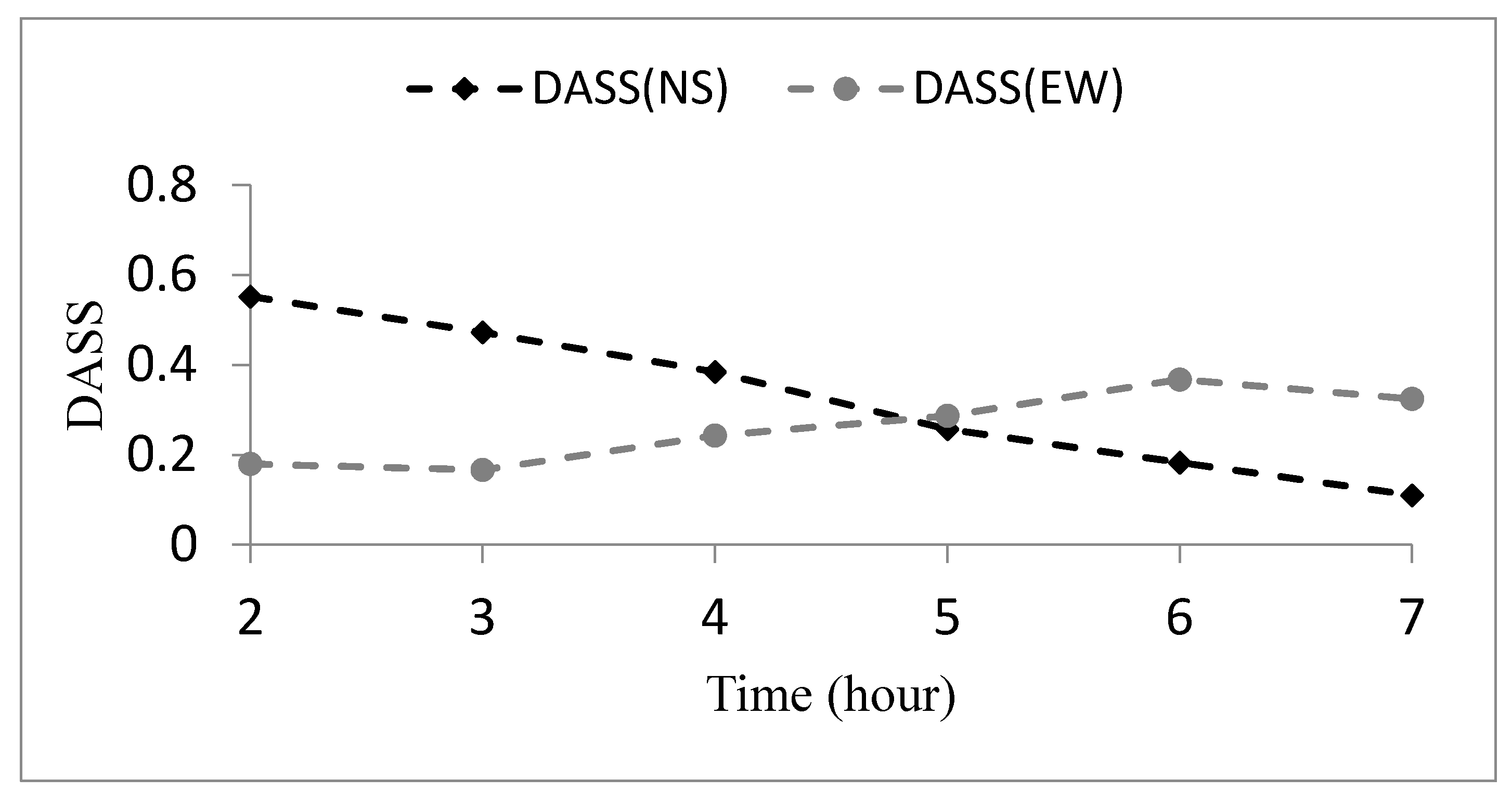

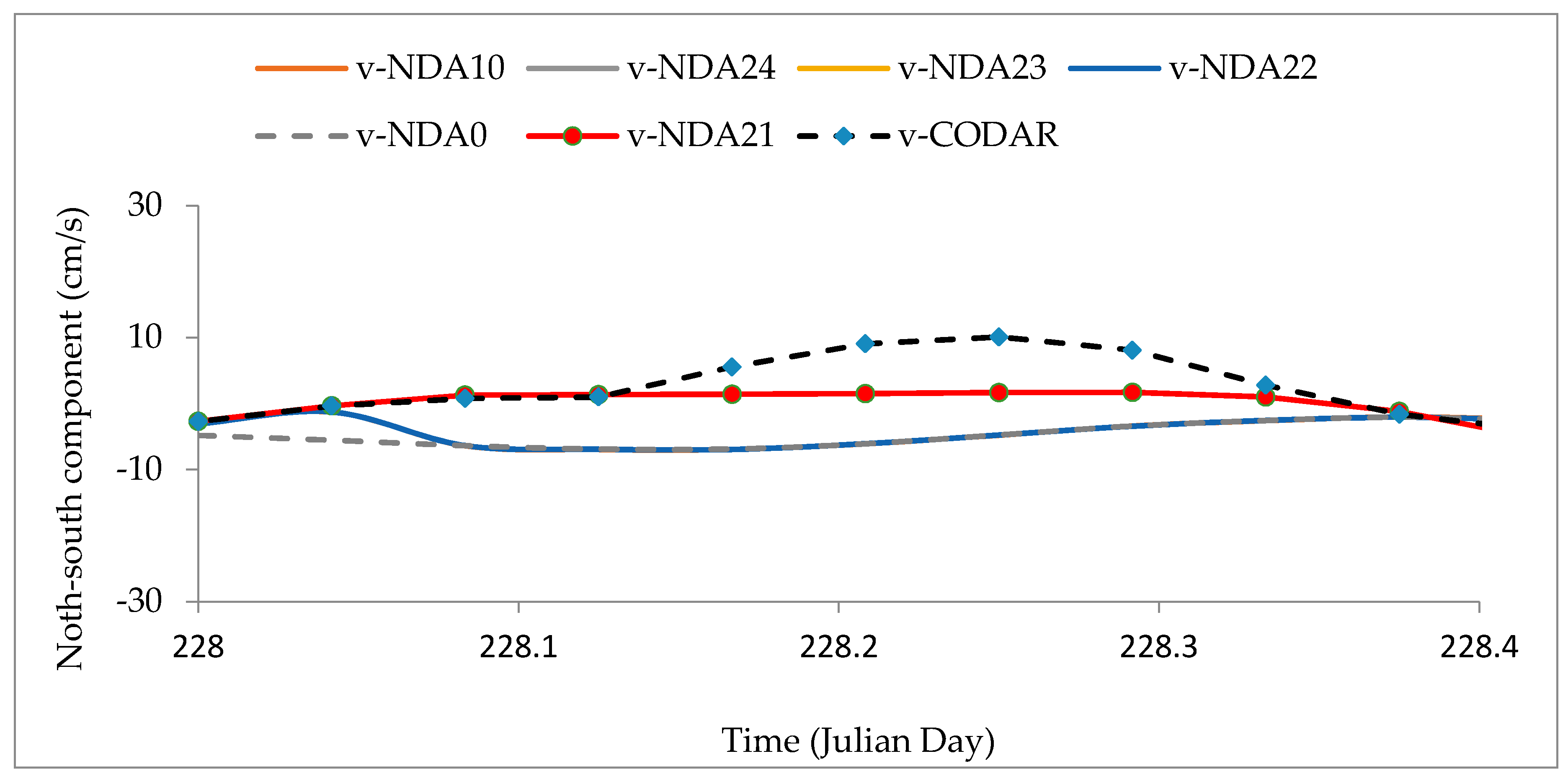
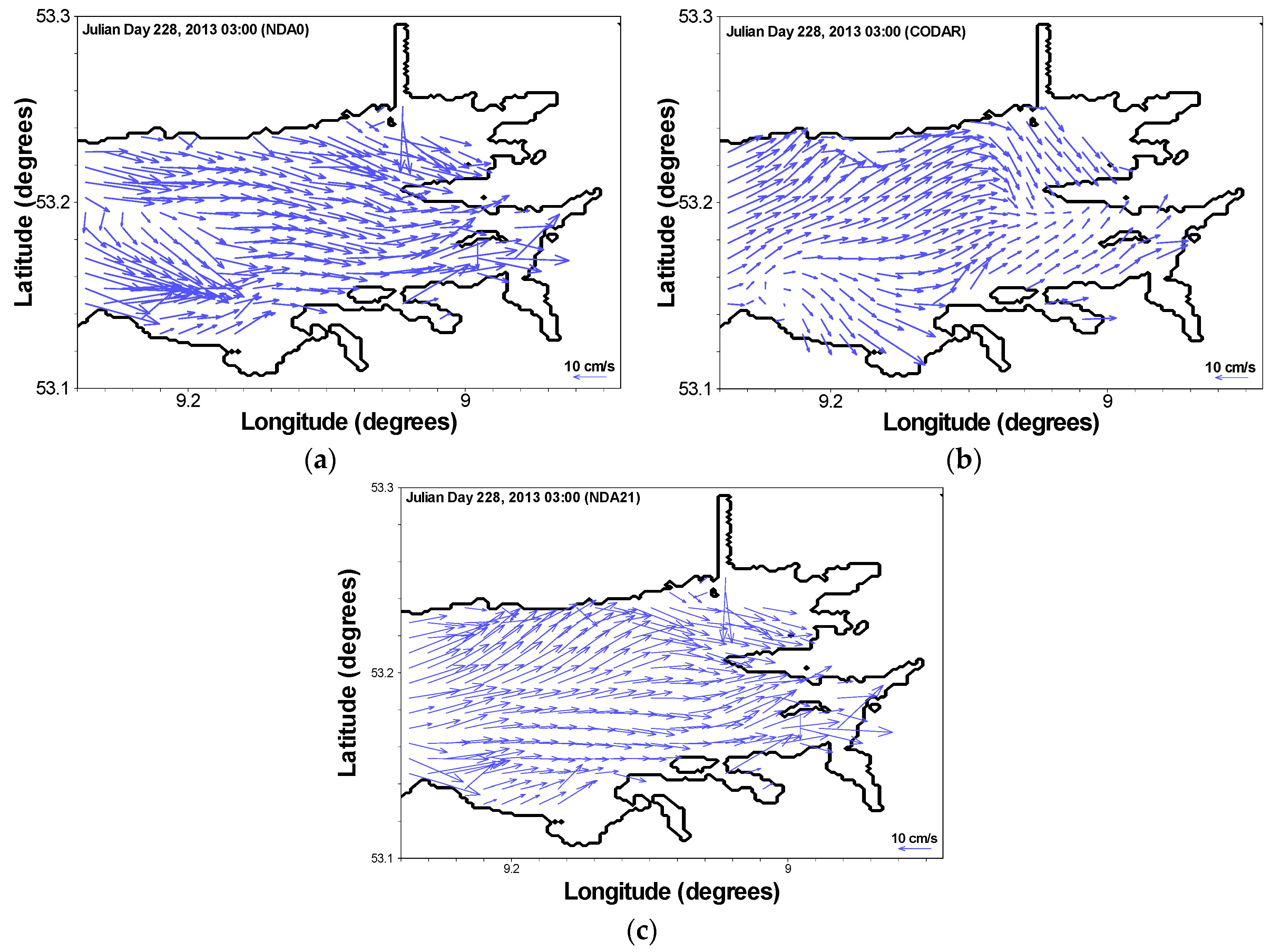
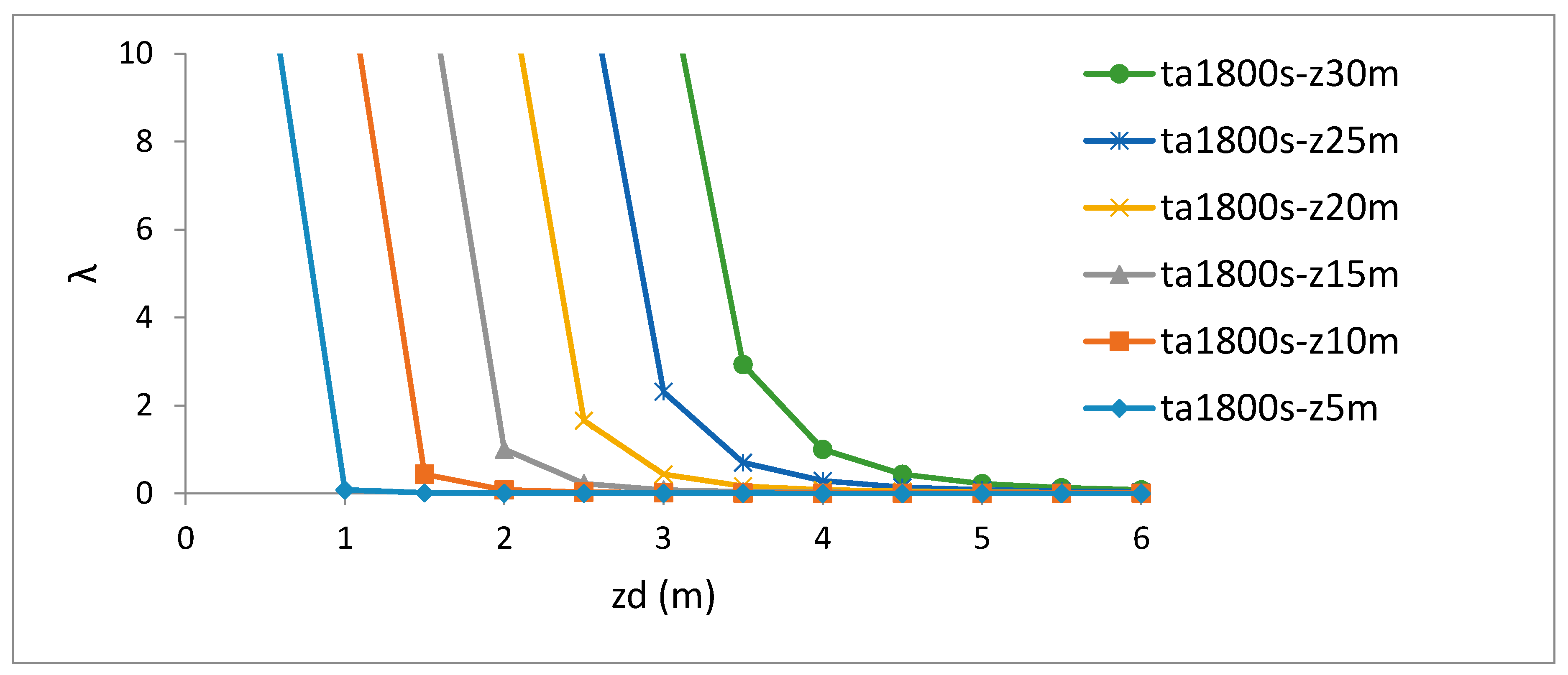
| Model | Zd (m) | Ta (s) | RMSE (u, cm/s) | RMSE (v, cm/s) | RMSE (u, v, cm/s) |
|---|---|---|---|---|---|
| NDA0 | - | - | 8.71 | 7.70 | 11.62 |
| NDA1 | 3 | 1200 | 79.61 | 67.79 | 104.56 |
| NDA2 | 4 | 1200 | 8.13 | 7.13 | 10.81 |
| NDA3 | 5 | 1200 | 8.11 | 7.15 | 10.81 |
| NDA4 | 6 | 1200 | 8.44 | 7.45 | 11.26 |
| NDA5 | 3 | 1500 | 63.26 | 53.93 | 83.13 |
| NDA6 | 4 | 1500 | 7.88 | 6.92 | 10.48 |
| NDA7 | 5 | 1500 | 8.22 | 7.25 | 10.96 |
| NDA8 | 6 | 1500 | 8.50 | 7.50 | 11.33 |
| NDA9 | 3 | 1800 | 52.43 | 44.69 | 68.89 |
| NDA10 | 4 | 1800 | 7.80 | 6.86 | 10.39 |
| NDA11 | 5 | 1800 | 8.29 | 7.31 | 11.06 |
| NDA12 | 6 | 1800 | 8.53 | 7.53 | 11.38 |
| NDA13 | 3 | 2100 | 44.71 | 38.14 | 58.77 |
| NDA14 | 4 | 2100 | 7.81 | 6.86 | 10.40 |
| NDA15 | 5 | 2100 | 8.35 | 7.37 | 11.14 |
| NDA16 | 6 | 2100 | 8.55 | 7.56 | 11.41 |
| NDA17 | 3 | 2400 | 38.97 | 33.26 | 51.24 |
| NDA18 | 4 | 2400 | 7.84 | 6.90 | 10.44 |
| NDA19 | 5 | 2400 | 9.39 | 7.40 | 11.96 |
| NDA20 | 6 | 2400 | 8.57 | 7.57 | 11.43 |
| Model | NDA0 | NDA21 | DA22 | NDA23 | NDA24 | NDA10 |
|---|---|---|---|---|---|---|
| Cycle Length (minutes) | - | MS * | 1 | 5 | 15 | 60 |
| RMSE (u, cm/s) | 8.2131 | 7.3618 | 8.2189 | 8.2087 | 8.2138 | 8.2054 |
| RMSE (v, cm/s) | 6.0902 | 5.2062 | 6.1026 | 6.093 | 6.0938 | 6.0956 |
| RMSE (u, v, cm/s) | 10.2247 | 9.0167 | 10.2368 | 10.2229 | 10.2275 | 10.2218 |
| Z (m) | (z/zd) | Exp (z/zd) | λ |
|---|---|---|---|
| 5 | 1.25 | 3.49 | 0.00 |
| 15 | 3.75 | 42.52 | 0.02 |
| 20 | 5.00 | 148.41 | 0.08 |
| 25 | 6.25 | 518.01 | 0.29 |
| 30 | 7.50 | 1808.04 | 1.00 |
| 35 | 8.75 | 6310.69 | 3.51 |
© 2017 by the authors. Licensee MDPI, Basel, Switzerland. This article is an open access article distributed under the terms and conditions of the Creative Commons Attribution (CC BY) license (http://creativecommons.org/licenses/by/4.0/).
Share and Cite
Ren, L.; Hartnett, M. Hindcasting and Forecasting of Surface Flow Fields through Assimilating High Frequency Remotely Sensing Radar Data. Remote Sens. 2017, 9, 932. https://doi.org/10.3390/rs9090932
Ren L, Hartnett M. Hindcasting and Forecasting of Surface Flow Fields through Assimilating High Frequency Remotely Sensing Radar Data. Remote Sensing. 2017; 9(9):932. https://doi.org/10.3390/rs9090932
Chicago/Turabian StyleRen, Lei, and Michael Hartnett. 2017. "Hindcasting and Forecasting of Surface Flow Fields through Assimilating High Frequency Remotely Sensing Radar Data" Remote Sensing 9, no. 9: 932. https://doi.org/10.3390/rs9090932




